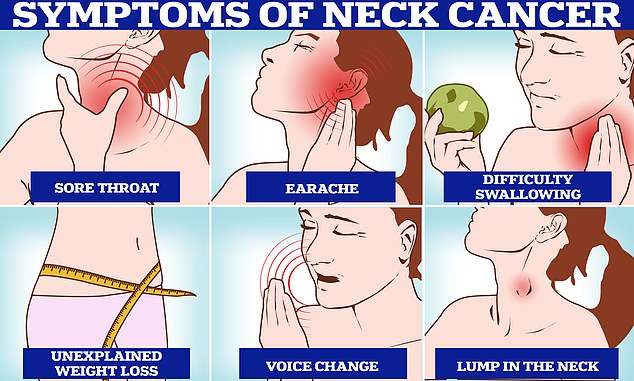Regular brushing and flossing may reduce the risk of head and neck cancer, a promising new study suggests.
Research has long shown that high levels of bacteria associated with gum disease can increase your chances of developing the condition, as well as diabetes and high blood pressure.
But until now, experts didn’t know which specific bacteria in people’s mouths might be linked to head and neck cancer.
American scientists have discovered more than a dozen species that together they say increase the risk of head and neck squamous cell carcinoma (the most common type) by 50 percent.
The researchers say their findings highlight the importance of good oral hygiene, which often includes brushing twice a day, flossing and regular visits to the dentist.
The researchers say their findings highlight the importance of good oral hygiene, which often includes brushing your teeth twice a day and visiting the dentist regularly.
However, surveys have shown that only three in ten Britons floss daily.
Professor Richard Hayes, co-author of the study and a population health expert at New York University (NYU), said: ‘Our results provide yet another reason to maintain good oral hygiene habits.
‘Brushing and flossing can not only help prevent periodontal disease, but may also protect against head and neck cancer.’
The study’s lead author, Soyoung Kwak, a postdoctoral researcher in population health at New York University, added: ‘Our findings offer new insight into the relationship between the oral microbiome and head and neck cancers.
‘These bacteria could serve as biomarkers for experts to identify those at high risk.’
Around 12,400 new cases of head and neck cancer are diagnosed each year in the UK, and approximately 66,000 in the US.
But symptoms can be difficult to spot, according to the NHS.
In the UK, head and neck cancer is the eighth most common cancer, accounting for three per cent of all new cases.
There are more than 30 areas within the head and neck where tumors can develop.
Nine out of ten head and neck cancers start in squamous cells, says Macmillan Cancer Support.
Squamous cells are flat, skin-like cells that cover the lining of the mouth, nose, larynx, thyroid, and throat.
Although most often diagnosed in older adults, oral cancers are increasingly common in younger people.
Doctors say the human papillomavirus (HPV), a normally harmless virus transmitted sexually and through skin-to-skin contact, could be behind the rise.
In the study, researchers analyzed data on the diet, lifestyle and medical history of nearly 160,000 Americans.
Volunteers were asked to rinse with mouthwash and provide saliva samples that were then preserved and analyzed to determine the amount and types of microbes present.
During a 15-year follow-up, 236 participants were diagnosed with head and neck squamous cell carcinoma.

Around 12,400 new cases of cancer are diagnosed each year in the UK, and around 66,000 in the US. However, the symptoms of cancer can be difficult to spot, according to the NHS.
Their oral microbial DNA was compared to that of 458 participants who had remained cancer-free.
Factors that could bias the results were also taken into account: smoking history, age and alcohol consumption.
Writing in the diary JAMA Oncology JournalResearchers said 13 species of the hundreds of different bacteria routinely found in the mouth were found to increase or reduce cancer risk.
This group was associated with a 30 percent higher likelihood of developing the disease.
Combined with five other species that commonly cause gum disease, the overall risk increased by 50 percent.
However, they added that the study does not establish a direct link between bacteria and cancer, but rather identifies a correlation.
Study co-author and associate director of population research at the Perlmutter Cancer Center said, “Now that we’ve identified the key bacteria that may contribute to this disease, we now plan to explore the mechanisms that allow them to do so and how we can best intervene.”

